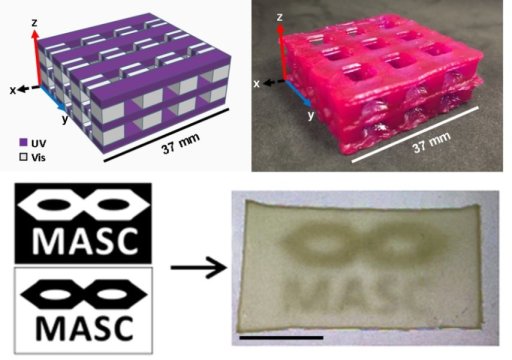[ad_1]
3D printing has revolutionized the fields of healthcare, biomedical engineering, manufacturing and art design.
Successful applications have come despite the fact that most 3D printing techniques can only produce parts made of one material at a time. More complex applications could be developed if 3D printers could use different materials and create multi-material parts.
New research uses different wavelengths of light to achieve this complexity. Scientists at the University of Wisconsin-Madison developed a novel 3D printer that uses patterns of visible and ultraviolet light to dictate which of two monomers are polymerized to form a solid material. Different patterns of light provide the spatial control necessary to yield multi-material parts. The work was published Feb. 15 in the journal Nature Communications.
“As amazing as 3D printing is, in many cases it only offers one color with which to paint,” says UW-Madison Professor of Chemistry A.J. Boydston, who led the recent work with his graduate student Johanna Schwartz. “The field needs a full color palette.”
Boydston and Schwartz knew that improved printing materials required a chemical approach to complement engineering advances.
“This is a shift in how we think about 3D printing with multiple types of materials in one object,” Boydston says. “This is more of a bottom-up chemist’s approach, from molecules to networks.”
3D printing is the process of making solid three-dimensional objects from a digital file by successively adding thin layers of material on top of previous layers. Most multi-material 3D printing methods use separate reservoirs of materials to get different materials in the right positions.
But Boydston realized that a one-vat, multiple-component approach — similar to a chemist’s one-pot approach when synthesizing molecules — would be more practical than multiple reservoirs with different materials. This approach is based on the ability of different wavelengths of light to control which starting materials polymerize into different sections of the solid product. Those starting materials start as simple chemicals, known as monomers, that polymerize together into a longer string of chemicals, like how plastic is made.
“If you can design an item in PowerPoint with different colors, then we can print it with different compositions based on those colors,” Schwartz says.
Researchers create multiple digital images that, when stacked, produce a three-dimensional design. The images control whether ultraviolet or visible light is used to polymerize the starting materials, which controls the final material and its properties, like stiffness. The researchers simultaneously direct light from two projectors toward a vat of liquid starting materials, where layers are built one-by-one on a platform. After one layer is built, the build platform moves up, and light helps build the next layer.
The major hurdle Boydston and Schwartz faced was optimizing the chemistry of the starting materials. They first considered how the two monomers would behave together in one vat. They also had to ensure that the monomers had similar curing times so that the hard and soft materials within each layer finished drying at approximately the same time.
With the right chemistry in place, Boydston and Schwartz could now dictate exactly where each monomer cured within the printed object by using ultraviolet or visible light.
“At this stage, we’ve only accomplished putting hard materials next to soft materials in one step,” Boydston says. “There are many imperfections, but these are exciting new challenges.”
Now, Boydston wants to address these imperfections and answer open questions, such as what other monomer combinations can be used and whether different wavelengths of light can be used to cure these new materials. Boydston also hopes to assemble an interdisciplinary team that can increase the impact of wavelength-controlled, multi-material 3D printing.
The researchers’ novel approach to multi-material 3D printing could enable designers, artists, engineers and scientists to create significantly more complex systems with 3D printing. Applications could include the creation of personalized medical devices, such as prostheses, or the development of simulated organs and tissues. Medical students could use these synthetic organs for training instead of, or before working with, live patients.
Using chemical methods to eliminate an engineering bottleneck is exactly what the 3D printing industry needs to move forward, says Schwartz.
“It is this interface of chemistry and engineering that will propel the field to new heights,” Schwartz says.
This work was funded by the Army Research Office (Grant No. W911NF-17-1-0595) and the National Science Foundation Graduate Research Fellowship Program (J.J.S. — Grant No. DGE-1256082).
[ad_2]















